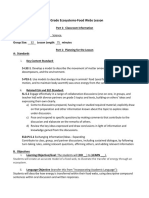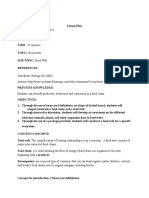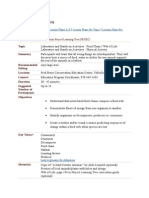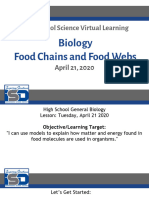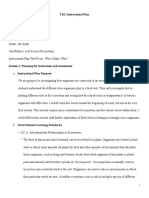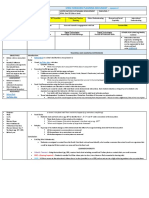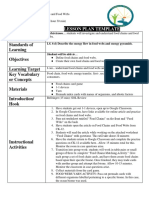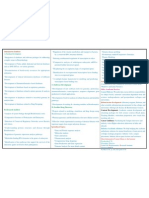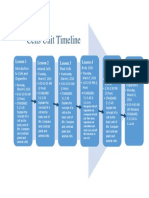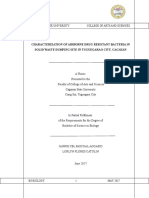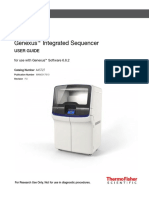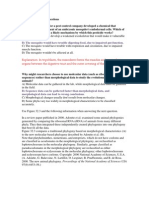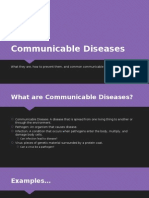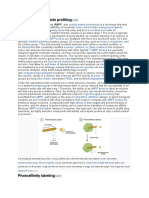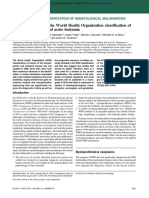Lesson Topic: Food Webs in an Ecosystem
Objective:
Students will be able to:
1. Identify the parts of a food chain and food web.
2. Explain how energy flows through a food web.
3. Simulate a food web using a yarn ball.
4. Draw, label, and create their own food web.
Time Required: 75 minutes
Materials Needed:
● Ball of yarn or string
● Sticker name tags (Some way of labeling students as an assigned animal)
● White paper (one per student)
● Colored pencils
● Teacher computer with internet access
● Projector/Smartboard
● Image of ecosystem (attached)
● Food Webs in an Ecosystem handout (attached)
Teacher Preparation:
● Assign a Legends of Learning Instructional Quick Play playlist for the day(s) you will
be teaching the lesson.
○ Instructional - Middle School - Food Webs in an Ecosystem
● Make copies of the Food Webs in an Ecosystem Worksheet (1 per student)
Engage (10 minutes):
1. Show the image of an ecosystem (attached) on the Smartboard or projector.
2. In pairs, have students write down everything that they notice about the image
a. Animals, plants, landforms, bodies of water, etc.
3. Discuss as a class what the partnerships noticed from the image.
4. Explain to students “This image is an example of an ecosystem. You all came up with
many animals and plants that live within this ecosystem. Today we are going to talk
about how they are all connected.”
Explore (20 minutes):
1. Have your students sign in to Legends of Learning. Instruct students to complete the
Instructional playlist.
2. As students complete the assigned game, students should fill out the vocabulary
portion of the Food Webs in an Ecosystem handout.
3. Assist students as needed during game play, pause playlist if you need to address
content or questions to the entire class.
Explain (15 minutes):
1. Review vocabulary from the Food Webs in an Ecosystem handout by talking about
1
� specific examples (from the image or other examples students bring up).
a. Producer - plants, produce their own food using photosynthesis, begin food
chains/webs
b. Consumer - animals eat other plants or animals to get nutrients because they
cannot make their own food.
c. Decomposers - organisms that eat decaying matter (dead plants and animals).
Bacteria and fungi are examples of decomposers. they break things down and
release the nutrients back into the soil for the producers to use.
d. Herbivore - organisms that mainly eat plants
e. Omnivore - organisms that eat plants and animals
f. Carnivore - organisms that mainly eat meat/other animals
g. Food Chain - sequence of organisms showing how the energy flows. It is one
path.
h. Food Web - network of many food chains, complex, shows how organisms are
connected through many paths.
2. As a class, have the students help you come up with a food chain and write or draw it
on the board.
a. What should our food web start with?
i. Answer: producer
b. What is an animal that would eat this producer?
i. Answer: any consumer (herbivore or omnivore)
c. What kind of organism do we need to complete the cycle of the food web?
i. Answer: decomposer
3. Next, have students come to the board and add other animals and organisms to the
food chain to create a food web.
Elaborate (10 minutes):
1. Assign each student one organism from the Food Web Chart (attached).
2. Pass out a sticker name tag and have the students write the name of their organism
on the sticker and place it visibly on their shirt.
3. Have students look at the Food Web Chart on the handout (attached).
4. Put students in large groups (ensure that there are producers, consumers, and
decomposers represented in each group).
5. Pass out a ball of yarn to each group. Starting with a producer, have a producer hold
the loose end of the yarn ball, then have them throw the yarn ball to a consumer that
would eat it.
6. The consumer will hold the loose yarn piece taught and then throw it to the next
consumer and so on and so forth (students can reference chart if necessary).
7. At the end of the activity, each person in the group should be part of the yarn food
web, revealing how an ecosystem is connected and how energy is passed and cycled.
8. Explain to students “You all have just demonstrated how the energy is passed and
cycled through a food web. Each of you is an important part of how the ecosystem
works.”
a. What do you think would happen if one of the organisms in the food web
disappeared?
2
� i. Answer: The animals that eat the organism would have to eat
something else which would run out quicker, the food the organism eats
would then go unchecked, etc.
9. When each group has done the activity a couple of different ways, it could be
interesting to try and connect the whole class in a food web! Give it a try!
Evaluate (20 minutes):
1. Give each student a piece of paper and colored pencils.
2. Tell students “Using the Food Web handout, draw, color, and label your own food web.
Follow the directions as indicated on the handout.”
Additional Lesson Strategies:
● To use Legends for additional instruction, create a custom playlist with an i nstructional
game and pre and post assessment.
● To use Legends for a quick formative assessment, create a 5-question assessment in
a playlist.
● To use Legends for a student-directed experience, create a targeted freeplay playlist.
● Encourage students to play on their own at home in Legends of Learning: Awakening
for a student-driven experience including avatars, battling, and quests all centered
around topics they are covering in class.
3
� Food Webs in an Ecosystem
While playing the Legends of Learning game, write in the following
vocabulary.
Producer -
Consumer -
Decomposers -
Herbivore -
Omnivore -
Carnivore -
Food Chain -
Food Web -
4
�Food Web Chart
Use the chart below to learn more about what these animals eat.
What do they eat?
Grass Makes its own food
Scorpion Grasshoppers, rats
Grasshopper Grass, flowers, butterflies
Fox Squirrels, rabbits, birds, frogs, snakes, rats, lizards
Eagle Squirrels, rabbits, birds, frogs, snakes, rats, lizards
Snake Rabbits, squirrels, frogs, rats, birds, rabbits,
Corn Makes its own food
Flower Makes its own food
Butterfly Flowers
Frog Butterflies, dragonflies
Rat Nuts, corn, butterflies, fruit
Bird Nuts, grass, flowers, dragonflies, scorpions
Wolf Birds, deer, rabbits, snakes, squirrels, rats
Rabbit Corn, flowers, nuts, grass
Squirrel Corn, flowers, nuts, grass
Fungi Dead things
Bacteria Dead things
Deer Grass, flowers, nuts, corn
Lizard Butterflies, grasshoppers, scorpions
Hawk Squirrels, rabbits, birds, frogs, snakes, rats, lizards
Dragonflies Butterflies, insects
Nuts Make their own food
5
�Create your own Food Web in the box below. Choose at least 6 organisms
from the chart to create a food web.
Your food web should include:
● A colored drawing of each organism
● A label of producer, consumer, or decomposer of each organism
● A label of the organism’s name next to its picture
6
�Ecosystem Image
This Photo by Unknown Author is licensed under CC BY-SA-NC







